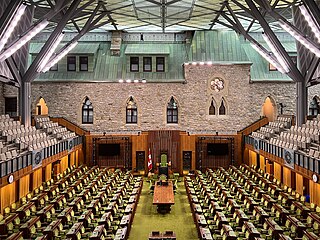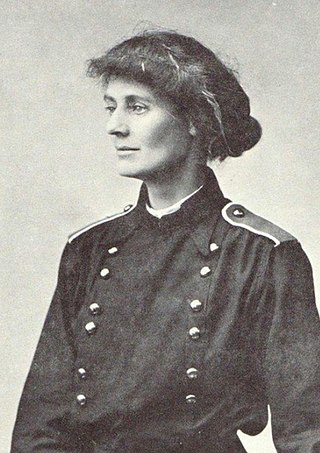Related Research Articles

The House of Commons of Canada is the lower house of the Parliament of Canada. Together with the Crown and the Senate of Canada, they comprise the bicameral legislature of Canada.
Gender representation has been a significant issue in Canadian politics.
Upon the dissolution of the 39th Canadian Parliament, 65 of the 308 seats were held by women. Canada ranks 45th in the world in representation of women in the national lower house.
Widow's succession was a political practice prominent in some countries in the early part of the 20th century, by which a politician who died in office was directly succeeded by their widow, either through election or direct appointment to the seat. Many of the earliest women to hold political office in the modern era attained their positions through this practice. It also occurred when politicians stood down from a particular office.

The representation of women in the House of Commons of the United Kingdom has been an issue in the politics of the United Kingdom at numerous points in the 20th and 21st centuries. Originally debate centred on whether women should be allowed to vote and stand for election as Members of Parliament. The Parliament Act 1918 gave women over 21 the right to stand for election as a Member of Parliament. The United Kingdom has had three female Prime Ministers: Margaret Thatcher (1979–1990), Theresa May (2016–2019), and Liz Truss (2022). The publication of the book Women in the House by Elizabeth Vallance in 1979 highlighted the under-representation of women in Parliament. In more modern times concerns about the under-representation of women led the Labour Party to introduce and, decades later, abandon all-women short lists, something which was later held to breach discrimination laws.
The 41st Canadian Parliament includes a record number of female Members of Parliament, with 76 women elected to the House of Commons of Canada in the 2011 election. This represents a gain of seven seats over the previous record of 69 women in the 40th Canadian Parliament. By contrast, the 112th United States Congress had 72 women sitting in the 435-seat United States House of Representatives, and the 113th United States Congress has 81.
The 42nd Canadian Parliament includes a record number of female Members of Parliament, with 88 women elected to the 338-member House of Commons of Canada (26%) in the 2015 election. This represents a gain of twelve seats over the previous record of 76 women in the 41st Canadian Parliament. By contrast, the 114th United States Congress had 105 women sitting in the 435-seat United States House of Representatives.
Women were first allowed to vote at the federal level in Canada in the 1917 general election in connection with military service, and were allowed to vote under the same conditions as men beginning on May 24, 1918. The next four elections saw only one woman elected: Agnes Macphail. The 1936 election saw two women in the House together for the first time. A by-election in 1941 saw a woman elected to the governing caucus for the first time. The 22nd federal election in 1953 was a slight breakthrough, electing four women, which was 1.5% of the House. Every Parliament thenafter would have at least two women at a time, except for the 28th Parliament from 1968 to 1972, in which Grace MacInnis was the only woman. Then 30th Parliament, elected in 1974, was another breakthrough, containing nine women MPs following the general election and rising to ten due to a by-election in 1976. The number of women in the House would not fall below ten again.
During the 15th Canadian Parliament, there was no change in representation by women. Four women ran for seats in the Canadian House of Commons in the 1925 federal election but Agnes Macphail, first elected in 1921, continued to be the only woman elected.
During the 16th Canadian Parliament, women sat as members for the first time in both the House of Commons and the Senate. Two women ran for seats in the Canadian House of Commons in the 1926 federal election but Agnes Macphail, first elected in 1921, continued to be the only woman elected.
During the 17th Canadian Parliament, the number of sitting women senators increased. Ten women ran for seats in the Canadian House of Commons in the 1930 federal election but Agnes Macphail, first elected in 1921, continued to be the only woman elected. Cairine Wilson continued to sit as a member of the Senate.
During the 18th Canadian Parliament, two women sat in the House of Commons for the first time. Sixteen women ran for seats in the Canadian House of Commons in the 1935 federal election. Agnes Macphail, first elected in 1921, was reelected in the newly created riding of Grey—Bruce. Martha Black, running in the place of her sick husband George Black as an independent Conservative, was elected for the Yukon riding, becoming the second woman to be elected to the House of Commons. Cairine Wilson and Iva Campbell Fallis continued to sit as members of the Senate.
During the 19th Canadian Parliament, for the first time, a woman sat as a member of the party holding the majority in the House of Commons. Nine women ran for seats in the Canadian House of Commons in the 1940 federal election. Dorise Nielsen was elected in the North Battleford riding as a Unity member; she was the third woman and the first Communist to sit in the House of Commons. Agnes Macphail, first elected in 1921, was defeated. Martha Black chose to step aside to allow her husband George Black to run for reelection. Cairine Wilson and Iva Campbell Fallis continued to sit as members of the Senate.
During the 20th Canadian Parliament, women continued to sit as members of both the House of Commons and the Senate. Nineteen women ran for seats in the Canadian House of Commons in the 1945 federal election. Gladys Strum was elected in the Qu'Appelle riding as a Co-operative Commonwealth Federation member; she was the fourth woman to sit in the House of Commons and the first woman to serve as president of a Canadian political party. Cairine Wilson and Iva Campbell Fallis continued to sit as members of the Senate.
The number of women sitting in the House of Commons decreased to two during the 23rd Canadian Parliament; the number of women senators remained at five. 29 women ran for seats in the Canadian House of Commons in the 1957 federal election.
The number of women sitting in the House of Commons remained at five during the 25th Canadian Parliament; the number of women senators remained at six. 26 women ran for seats in the Canadian House of Commons in the 1962 federal election; four women out of five incumbents were reelected. Margaret Aitken was defeated when she ran for reelection; Isabel Hardie became the first woman elected to the House of Commons from the Northwest Territories.
The number of women sitting in the House of Commons increased to six during the 26th Canadian Parliament; the number of women senators remained at six. 40 women ran for seats in the Canadian House of Commons in the 1963 federal election; two women out of five incumbents were reelected. Ellen Fairclough, Isabel Hardie and Margaret Mary Macdonald were defeated when they ran for reelection. Pauline Jewett and Margaret Konantz were elected to the House of Commons in the general election; Eloise Jones and Margaret Rideout were elected in by-elections held in June 1964.
The number of women sitting in the House of Commons decreased to four during the 27th Canadian Parliament; the number of women senators returned to six. 37 women ran for seats in the Canadian House of Commons in the 1965 federal election; three women out of six incumbents were reelected. Pauline Jewett and Margaret Konantz were defeated when they ran for reelection; Eloise Jones did not run for reelection. Grace MacInnis was also elected to the House of Commons in the general election, becoming the first woman elected to the House of Commons from British Columbia.
The 43rd Canadian Parliament once again set a record number of female Members of Parliament, with 98 women elected to the 338-member House of Commons of Canada (28.9%) in the 2019 election. Of those 98 women, 31 were elected for the first time in the 2019 election. 2 more women were elected in by-elections in October 2020, reaching the historic milestone of 100 women in the House of Commons for the first time. This represents a gain of twelve seats over the previous record of 88 women in the 42nd Canadian Parliament. By contrast, the 116th United States Congress had 102 women sitting in the 435-seat United States House of Representatives (23.4%).
The 44th Canadian Parliament includes a record number of female Members of Parliament, with 103 women elected to the 338-member House of Commons of Canada (30.5%) in the 2021 election. Of those 103 women, 22 were elected for the first time in the 2021 election. This represents a gain of five seats over the previous record of 98 women elected at the beginning of the 43rd Canadian Parliament, and a gain of three seats from the record high of 100 women during the previous parliamentary session following by-elections.
References
- ↑ "Women's Representation in the House of Commons: A Stalemate?". Canadian Parliamentary Review.
- ↑ Parliament of Canada: Women Candidates in General Elections